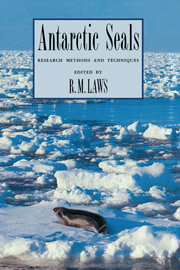Book contents
- Frontmatter
- Contents
- List of contributors
- Preface
- Introduction
- 1 Identification of species
- 2 Estimation of population sizes
- 3 Immobilization and capture
- 4 Marking techniques
- 5 Telemetry and electronic technology
- 6 Behaviour
- 7 Killing methods
- 8 Morphometrics, specimen collection and preservation
- 9 Genetic-based studies for stock separation
- 10 Collection of material for the determination of organochlorine and heavy metal levels
- 11 Age determination
- 12 Reproduction
- 13 Diet
- 14 Bioenergetics
- 15 Development of technology and research needs
- 16 Appendices
- Index
7 - Killing methods
Published online by Cambridge University Press: 05 February 2010
- Frontmatter
- Contents
- List of contributors
- Preface
- Introduction
- 1 Identification of species
- 2 Estimation of population sizes
- 3 Immobilization and capture
- 4 Marking techniques
- 5 Telemetry and electronic technology
- 6 Behaviour
- 7 Killing methods
- 8 Morphometrics, specimen collection and preservation
- 9 Genetic-based studies for stock separation
- 10 Collection of material for the determination of organochlorine and heavy metal levels
- 11 Age determination
- 12 Reproduction
- 13 Diet
- 14 Bioenergetics
- 15 Development of technology and research needs
- 16 Appendices
- Index
Summary
Destruction comes most swiftly upon seals when they are smitten on the head.
Oppian, Halieutica v. 1.391.Introduction
Killing of seals has attracted more attention than any other group of animals and several official publications on approved methods have been issued, perhaps largely on account of public concern about inhumane methods alleged to be used in commercial seal hunting. In the past much of the information on seal biology was obtained from post-mortems carried out on animals taken commercially, killed for dog food or specifically for the purpose of biological research. However, few species are now commercially exploited – certainly no Antarctic species – and very few seals are taken for dog food; also there has been a change in public attitudes on killing animals for scientific purposes and nondestructive methods can now be used to obtain much of the data formerly obtained in that way (e.g. capture, drug immobilization, blood sampling and telemetry). Nonetheless, some information and material is still only obtainable from dead animals. Animals should not be killed unless absolutely necessary and humane methods must be used to avoid unnecessary suffering. (Appendix 16.7.) It is likely that a scientist collecting seal material will in most cases choose a firearm to kill his specimens, though special methods may be required for particular purposes and chemical euthanasia will often be chosen when the animals are already restrained.
- Type
- Chapter
- Information
- Antarctic SealsResearch Methods and Techniques, pp. 155 - 160Publisher: Cambridge University PressPrint publication year: 1993
- 2
- Cited by



